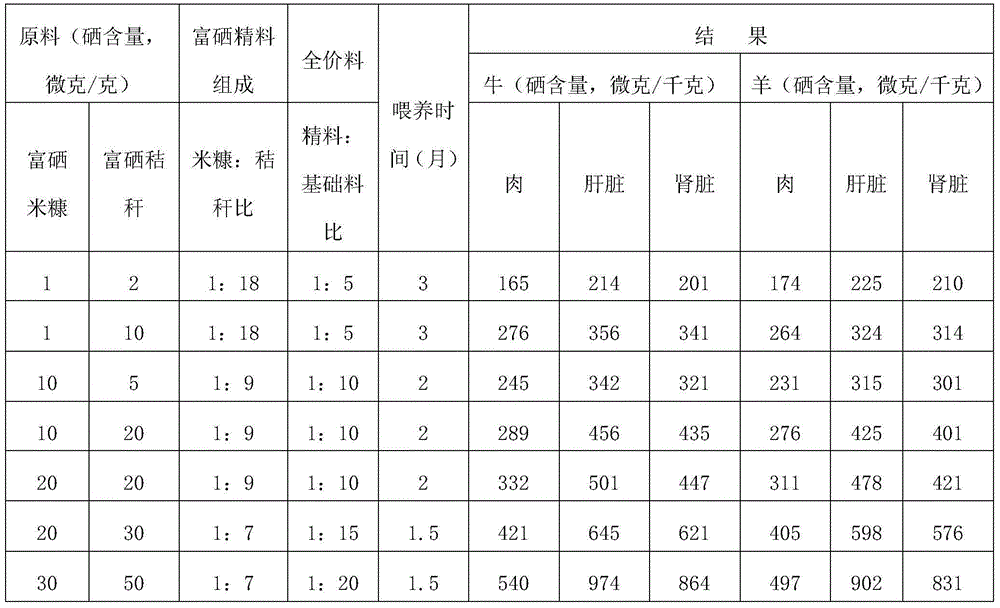Selenium-rich fine fodder for feeding cattle and sheep and using method thereof
A selenium-enriched and concentrate technology, applied in the field of selenium-enriched concentrate for cattle and sheep feeding, can solve problems such as animal poisoning absorption, and achieve the effects of solving animal poisoning, improving quality, and solving low absorption
- Summary
- Abstract
- Description
- Claims
- Application Information
AI Technical Summary
Problems solved by technology
Method used
Image
Examples
Embodiment 1
[0011] 1. Preparation of selenium-enriched concentrate: Select rice bran and straw, the by-products of rice that are fertilized with selenium during the planting process. The laboratory has measured that the selenium content of rice bran is 10 μg / g, and the selenium content of rice straw is 20 μg / g. More than 99% of selenium is selenoamino acid, and the selenium-enriched rice bran and selenium-enriched straw are dried and ultrafinely pulverized, and mixed and granulated according to 1:7 to prepare selenium-enriched concentrate.
[0012] 2. Application of selenium-enriched concentrate: mix the prepared selenium-enriched concentrate with the base material at a weight ratio of 1:10 to form a full-price feed, and feed it to beef cattle. After feeding for one and a half months, slaughter and send for inspection, and test in the laboratory The selenium content in the meat is 324 micrograms / kg, the selenium content in the liver is 545 micrograms / kg, and the selenium content in the kid...
Embodiment 2
[0014] 1. Preparation of selenium-enriched concentrate: Select rice bran and straw, the by-products of rice that are fertilized with selenium during the planting process. The laboratory has measured that the selenium content of rice bran is 10 μg / g, and the selenium content of rice straw is 20 μg / g. More than 99% of selenium is selenoamino acid, and the selenium-enriched rice bran and selenium-enriched straw are dried and ultrafinely pulverized, and mixed and granulated according to 1:7 to prepare selenium-enriched concentrate.
[0015] 2. Application of selenium-enriched concentrate: mix the prepared selenium-enriched concentrate with the base material at a weight ratio of 1:10 to form a full-price feed, and feed the mutton sheep. After one month of feeding, slaughter and send for inspection, and laboratory testing The selenium content in the meat is 374 micrograms / kg, the selenium content in the liver is 645 micrograms / kg, and the selenium content in the kidney is 566 microgr...
Embodiment 3
[0017] 1. Preparation of selenium-enriched concentrate: rice bran and straw, the by-products of rice fertilized with selenium fertilizer during planting, were selected. The laboratory measured that the selenium content of rice bran was 3 μg / g, and the selenium content of rice straw was 5 μg / g. More than 99% of selenium is selenoamino acid, and the selenium-enriched rice bran and selenium-enriched straw are dried and ultrafinely pulverized, and mixed and granulated at a ratio of 1:15 to prepare selenium-enriched concentrate.
[0018] 2. Application of selenium-enriched concentrate: mix the prepared selenium-enriched concentrate with base material at a weight ratio of 1:5 to form a full-price feed, and feed it to beef cattle. After 3 months of feeding, slaughter and send for inspection, and laboratory testing The selenium content in the meat is 214 micrograms / kg, the selenium content in the liver is 341 micrograms / kg, and the selenium content in the kidney is 265 micrograms / kg, r...
PUM
 Login to View More
Login to View More Abstract
Description
Claims
Application Information
 Login to View More
Login to View More - R&D
- Intellectual Property
- Life Sciences
- Materials
- Tech Scout
- Unparalleled Data Quality
- Higher Quality Content
- 60% Fewer Hallucinations
Browse by: Latest US Patents, China's latest patents, Technical Efficacy Thesaurus, Application Domain, Technology Topic, Popular Technical Reports.
© 2025 PatSnap. All rights reserved.Legal|Privacy policy|Modern Slavery Act Transparency Statement|Sitemap|About US| Contact US: help@patsnap.com

